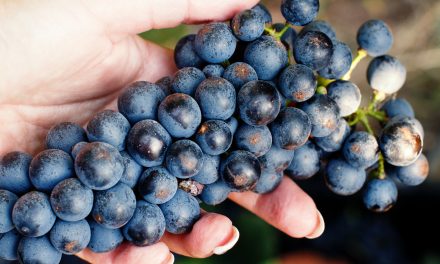It was an up and down weather season this summer. A couple of record heat waves and many wet, foggy mornings. The heat spells helped out suppressing Powdery Mildew which is not just a vineyard problem. I am sure some of you gardeners have run into it also with the ideal conditions of 60 to 80 degree days and foggy mornings here on the Central Coast. It doesn’t do well with temperatures above 90 degrees, so not as big a problem over the Grade in Paso Robles and was helpful on this side on those couple of hot days.
Powdery Mildew (PM) can be found in a host of commercial plants besides grapes, including strawberries, apples, roses, hops, basil, rosemary, cucurbits, and tomatoes. PM is a fungal disease that attacks a plant making a layer of many white-gray spores across the tops of the leaves. It can slow the growth of the plant and, if left untreated, will severely reduce fruit yield, quality, and quantity of flowers and fruit.
These spores are spread by the wind, vineyard crews, and machinery. We had a crew we borrowed from Edna Valley that had been working in a vineyard the day before that was infected with the PM help us finish up leaf pulling on a couple of acres in our bottom field next to the creek that was a nightmare to slow down growth because they tapped into the high water table.
It was always the worst spot for mildew with the combination of being where the fog (high humidity) took longer to dissipate, less sun because on the west side of the ranch in a hole and along with tall Eucalyptus and Sycamore trees surrounding the vineyard resulting in big wet vines shading the grapevines.
A couple of weeks later, when I was out spraying at night organic mineral oil, instead of fungicides, I got to that part of the field and noticed almost to the vine where the crew had been working that the vines had been taken over by PM and every grape cluster was shriveled up, black, and covered with the mold.
That was because they didn’t change their clothes after working in the other vineyard and carried the mildew with them. We had to go back in and douse the vines with organic mineral oil again (which encapsulated the PM) and then pick the grapes and bury them. When the leaves fell, we also cleaned them up and destroyed them. For the next couple of years, we had to treat that spot more than the rest of the vineyard. It is also important to keep the vineyards free of trash beneath the vines because it can overwinter in the vines and trash.
There are many different types of fungicides for PM, but because it can grow resistant to many fungicides and requires using more than just one different chemistry when spraying with fungicides. After many years of using sulfur, we switched to an organic mineral oil spray (only a 2 percent/gallon mix) which was not only very useful in controlling the spores but also aphids, mites, and other soft-shelled insects, plus no fungicide residue. That is because the oil would encapsulate the spores and bugs, causing them to suffocate. The only caution was you didn’t want it to get over 90 degrees for 48 hours because, if so, your vineyard would look like oil-fried chicken and a reason not used in hot climates. By the time you are reading this, growers will be on the downside of mildew suppression and thinking about getting prepared for harvest around the first of September.
Now there is a new piece of equipment being tested that utilizes UV-C light at night when it is more efficient and has been around for several years but is now being improved to be a possible tool for growers. In an article in Vineyard Magazine by Dan Clark, scientists have found that UV light damages the DNA of many organisms, but many diseases can repair the damage from the blue light found in sunlight. But at night, especially during the “dark period,” which lasts four hours and is two hours or more before dawn, there haven’t been any problems using UV light as compared to fungicide-treated crops in yields, cluster weight and appearance, the vine itself, nor in early quality tests of the wine.
A robot that is pulled by a tractor has been developed that houses UV lamps in a cylindrical shape with polished aluminum reflectors housed in a box with curtains on the backside. It is slow (2.8 mph), expensive, and with only four optimum hours at night, would require several to cover the vineyard, all of which need to be improved to be commercially viable. Most farm equipment innovations take time and experiment to make them viable. However, as a concept, it has proved to be excellent suppression of PM and mites, good suppression of sour rot, and mild suppression of downy mildew plus 100 percent organic. The positives far outweigh the negatives.






